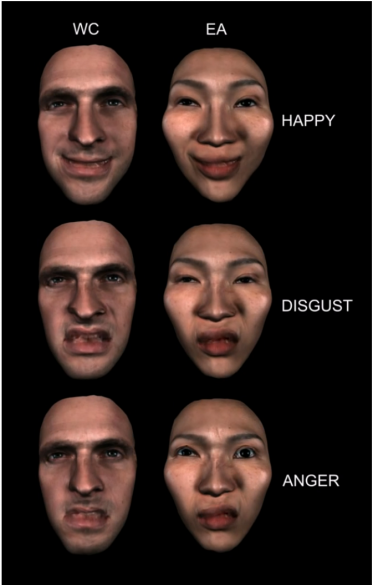
And yet another blow to the “race is only skin color” crowd – facial expressions differ across races:
You can tell a lot about a person’s emotional state by looking at their face. A quick glance can give you an idea of whether a person is, say, happy or angry, allowing you to modify your behaviour accordingly.
The rapid and accurate recognition of some emotional states – particularly fear or anger – would have been advantageous in our evolutionary history. For instance, being able to determine when someone is angry with you might give you time to run away before they attack.
For this reason, you might think the way emotions are expressed on the face would be the same across all races and not substantially influenced by culture.
But new research, published in the Proceedings of the National Academy of Sciences by psychologist Rachael Jack and colleagues seems to show this isn’t the case.
…
Observers, half of whom were Western Caucasian and half East Asian (with little experience of each other’s culture), were asked to categorise each animation as one of six basic emotions – anger, happiness, fear, sadness, disgust or surprise – or “other”, and judge the emotional intensity of each animation.
For Western Caucasian observers, the facial movements categorised as each of the six basic emotions appeared distinct and all observers identified the same emotions.
By contrast, these same distinct movements were not seen in the categorisations made by East Asians, who showed a high degree of overlap in the categorisation of certain movements. This was particularly the case between fear and surprise, as well as anger and disgust.
Other differences were also apparent between the observations of Western Caucasians and East Asians. In particular, the perception of emotional intensity in some expressions was cued by rapid changes to the eye region for East Asians, whereas Western Caucasians took their cues from other parts of the face.
This study, along with other research over the past decade, is forming a consistent argument: there are cultural differences in the kind of facial expression movements thought to constitute certain emotions.
First, notice how the authors are very careful to cast these differences in terms of “culture” rather than genetics; they won’t get published if they bring biology into this. Now there is probably a cultural (environmental) element to this, but it’s an oversimplification to point to it as the only factor. I would theorize that each person’s facial expressions are a combination of individual, environmental (cultural), and genetic (racial) factors. For example, as anecdotal evidence, I’ve personally noticed that I often have a hard time reading Asian faces, that I have a harder time reading the faces of Asians born in Asia than Asians born in America, and that this varies across individuals while still following that general rule. Secondly – and this is the big one – the “rapid and accurate recognition of some emotional states,” in large part conveyed by facial expressions, is fundamentally important to a smooth, comfortable, and harmonious society. Without this, offenses are not recognized, jokes are taken too far, discourse stalls, and emotions are generally misconstrued. It is probable that these difference are yet one more contributing factor to the growing distrust and social alienation in Western countries as diversity increases. Another corollary to this is in regards to interracial marriage and transracial adoption. Since we are all sinful humans, familial relationships are difficult enough without the added barrier of different facial expression paradigms within the same family. There is ancient wisdom in the Book of Tobit counseling us to “marry a woman from among the descendants of your ancestors; do not marry a foreign woman.”
| Tweet |
|
|
|




